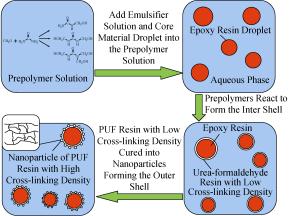1 Yuan, Y. C.; Yin, T.; Rong, M. Z.; Zhang, M. Q. Express Polym. Lett. 2008, 2, 238.

2 Mauldin, T. C.; Kessler, M. R. Int. Mater. Rev. 2010, 55,317.

3 White, S. R.; Sottos, N. R.; Geubelle, P. H.; Moore, J. S.; Kessler, M. R.; Sriram, S. R.; Brown, E. N.; Viswanathan, S. Nature 2001, 409, 749.
4 Kessler, M. R.; White, S. R. Composites, Part A 2001, 32,683.
5 Brown, E. N.; Kessler, M. R.; Sottos, N. R.; White, S. R. J. Microencapsulation 2003, 20, 719.
6 Liao, L. P.; Zhang, W.; Zhao, Y.; Li, W. J. Chem. Res.2010, 26, 496.
7 Liao, L. P.; Zhang, W.; Xin, Y.; Wang, H. M.; Zhao, Y.; Li, W. J. Chin. Sci. Bull. 2011, 56, 439.

8 Yuan, L.; Liang, G. Z.; Xie, J. Q.; Li, L.; Guo, J. Polymer2006, 47, 5338.

9 Yuan, L.; Liang, G. Z.; Xie, J. Q.; Guo, J.; Li, L. Polym. Degrad. Stab. 2006, 91, 2300.

10 Fan, C. J.; Zhou, X. D. Colloids Surf., A 2010, 363, 49.

11 Fan, C. J.; Zhou, X. D. Polym. Bull. 2011, 67, 15.

12 Yuan, L.; Liang, G. Z.; Xie, J. Q.; Li, L.; Guo, J. J Mater. Sci. 2007, 42, 4390.

13 Yuan, L.; Gu, A. J.; Liang, G. Z. Mater. Chem. Phys. 2008,110, 417.

14 Li, H. Y.; Wang, R. G.; Hu, H. L.; Liu, W. B. Appl. Surf. Sci. 2008, 255, 1894.

15 Du, G. B.; Lei, H.; Pizzi, A. J. Beijing Forestry Univ. 2009,31, 106 (in Chinese). (杜官本, 雷洪, Pizzi, A, 北京林业大学学报, 2009, 31,106.)
16 Hao, Z. X.; Li, Z.; Lin, R.; Gan, L. H.; Xu, Z. J.; Chen, L. W. Acta Chim. Sinica 2009, 67, 575 (in Chinese). (郝志显, 李铮, 林瑞, 甘礼华, 徐子颉, 陈龙武, 化学学 报, 2009, 67, 575.)
17 Li, A. P.; Kan, C. Y.; Du, Y.; Liu, D. S. Acta Phys.-Chim. Sin. 2006, 22, 873 (in Chinese). (李爱萍, 阚成友, 杜奕, 刘德山, 物理化学学报, 2006,22, 273.)
18 Ferra, J. M.; Mendes, A. M.; Costa, M. R. N.; Magalh?es, F. D.; Carvalho, L. H. J. Adhes. Sci. Technol. 2010, 24, 1535.

19 Park, B. D.; Jeong, H. W. Int. J. Adhes. Adhes. 2011, 05, 001.
20 Tian, Y.; Zhao, G. Z.; Liu, Y. Q.; Zhu, F. T.; Cao, Y. China Adhesives 2007, 16, 8 (in Chinese). (田雨, 赵贵哲, 刘亚青, 朱福田, 曹杨, 中国胶粘剂,2007, 16, 8.)
21 Minopoulou, E.; Dessipri, E.; Chryssikos, G. D.; Gionis, V.; Paipetis, A.; Panayiotou, C. Int. J. Adhes. Adhes. 2003, 23,473.













